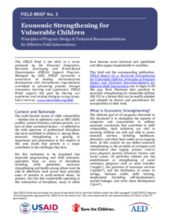WHAT: A brief illustration of ten economic strengthening tools that can be adapted to address child vulnerability due to HIV/AIDS, conflict, natural disaster, extreme poverty, or other contexts.
WHO: Social and community workers, program managers, multi-sectoral teams and donor agencies addressing child vulnerability and with specific responsibilities for social protection.
WHERE: While based on best practices of economic strengthening programs in HIV-affected households and communities in Africa, this guide is globally relevant.
WHY: Provides practical examples and do/don’t recommendations for implementing ten of the most common economic strengthening tools, which are: asset transfers, group-based savings, individual savings, microinsurance, legal asset protection, skills training, income-generating activities, job creation, market linkages, and business loans. Useful for practitioners seeking to incorporate an economic strengthening component into their child protection programs. Briefly shares guidance on which tool(s) to use, when appropriate, and how to use them.
N.B. This document is a summary of a larger report: Field Report #2, Save the Children, 2008S. Field Report #2 presents seven principles and accompanying lessons learned for program design, as well as concrete examples and technical recommendations for implementation of selected interventions. It also shares a listing of additional resources (how-to publications and comparative programming examples) where practitioners can seek more information.

